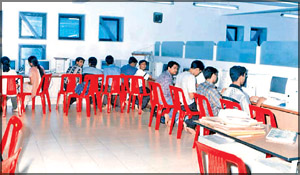The vision of a South Asian Community
Mohan LOHANI
SAARC, since its inception, has positively contributed to a
resurgence of South Asian consciousness over the years. Assertion of a
South Asian identity has emanated from the growth of such consciousness.
 Experts have, however, pointed out that SAARC still lacks the
vitality and vision to evolve into a South Asian community. The 14th
SAARC Declaration, inter alia, refers to the vision of a South Asian
community where there is ‘smooth flow of goods, services, peoples,
technologies, knowledge, capital culture and ideas in the region’. Experts have, however, pointed out that SAARC still lacks the
vitality and vision to evolve into a South Asian community. The 14th
SAARC Declaration, inter alia, refers to the vision of a South Asian
community where there is ‘smooth flow of goods, services, peoples,
technologies, knowledge, capital culture and ideas in the region’.
The region must meet some pie-requisites for realizing this vision,
and the leaders have underscored the importance of connectivity in this
context. They have agreed to improve intra-regional connectivity,
particularly physical, economic and people- to-people connectivity.
The decision to earmark one rural community as SAARC village in each
member state is a welcome step towards achieving the goal of a South
Asian community.
People-to-people contacts or connectivity is a recurring constant in
all the Summit Declarations (1985-2007). While inter-governmental
meetings and agreements do facilitate the process of regional
cooperation, for a much wider and more effective impact of such
cooperation, it is essential to supplement intergovernmental efforts by
responding to the aspirations of the peoples of South Asia, particularly
their spontaneous desire to communicate and cooperate with each other at
the people-to-people level.
It is not only government officials and representatives but also
academics, researchers, NGOs, civil society organizations, the business
community and other professional groups who can play a vital and active
role in promoting the SAARC spirit and giving impetus to regional
programs and projects’.
 Loki Raj Baral observes rightly: the South Asian region needs to be
revisited by scholars and policy planners in order to boost the spirit
of regional cooperation.’ Loki Raj Baral observes rightly: the South Asian region needs to be
revisited by scholars and policy planners in order to boost the spirit
of regional cooperation.’
The potential exists in the region for the generation of friendship,
goodwill and trust through interactions between the peoples, the
foundation for promoting community culture and fostering harmonious
relations in South Asia.
It was envisaged at the 3rd summit in 1987 that ‘SAARC should be
increasingly oriented to the people’s needs and aspirations so that the
masses of the region could be drawn to a greater extent into the
mainstream of SAARC activities.’
Such orientation is already overdue to bring about a qualitative
improvement in the general atmosphere of the region contributing to
peace, friendship and cooperation in the area.
The establishment of the South Asian University in India would
certainly help strengthen cooperation and dialogue on educational
matters through development of exchanges between academics, experts,
policymakers, students and teachers.
On the economic plane the same process needs to be replicated to
bring together the regions development planners, economists, policy
makers, administrators, university scholars, representatives of the
business community and the private sector in general for overall
economic development leading to progress and prosperity.
In an excellent paper presented at a seminar on SAARC last year,
Shreedhar Khatri quite succinctly observes: ‘An essential ingredient for
a vision of South Asia for the Third Decade is the people of the region’
Commenting on the flaw of the present SAARC process, Khatri sounds a bit
sarcastic when he remarks: ‘although the governments in theory represent
the people no questions have been raised as to how far they have
remained accountable, in achieving the objectives of the
|

Culture and education cornerstones of SAARC region |
organisation’.
It is not necessary to go too far to produce supporting evidence.
The 13th Summit Declaration categorically states: ‘the peoples of
South Asia are the real source of strength and driving force for SAARC’.
Since SAARC was created to promote the welfare of the peoples of the
region, all SAARC activities, programs, projects and proposals need to
be geared to serve the interests of the people, to respond to their
hopes and aspirations and to make them both agents and beneficiaries of
regional cooperation.
At the 14th SAARC summit last year the South Asian leaders reiterated
not only their commitment to the principles and objectives enshrined in
the Charter of the Association but also agreed, keeping uppermost in
mind the welfare of the peoples of the region, ‘to build a partnership
for prosperity and work towards shared economic cooperation, regional
prosperity, a better life for the people of South Asia, and equitable
distribution of benefits and opportunities of integration among the
peoples and the nations’.
The adoption of the Social Charter has been a major achievement of
SAARC. It is true that ‘the implementation of the Social Charter needs
focused attention.’
The South Asian leaders have called upon civil society organisations
to play a vital role in driving forward the implementation of the Social
Charter’ (The New Delhi Declaration, 2007). |

